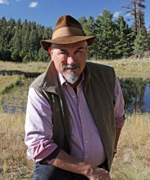— Alan Dulaney
 A deal is brewing on the Colorado River. For over a year, Arizona, Nevada, California, and the Bureau of Reclamation have been quietly meeting in Washington and other undisclosed locations to figure out how to avoid the seemingly inevitable: a declaration of shortage on the Colorado River and the imposition of the tiered system of cuts that mostly would impact Arizona (the result of the 1968 deal which overcame California’s opposition to the CAP canal). Discussions were supposed to be confidential. Then the Arizona Daily Star in Tucson broke the story, and now everyone is commenting.
A deal is brewing on the Colorado River. For over a year, Arizona, Nevada, California, and the Bureau of Reclamation have been quietly meeting in Washington and other undisclosed locations to figure out how to avoid the seemingly inevitable: a declaration of shortage on the Colorado River and the imposition of the tiered system of cuts that mostly would impact Arizona (the result of the 1968 deal which overcame California’s opposition to the CAP canal). Discussions were supposed to be confidential. Then the Arizona Daily Star in Tucson broke the story, and now everyone is commenting.
The tiered shortage levels set up in 2007 are tied to falling water-level elevations in Lake Mead, the major reservoir for the Lower Basin. At 1075 feet, the first shortage is declared, and Arizona is cut 320,000 acre-feet (AF), all from the CAP canal. Nevada takes a hit too, but much smaller, given its smaller allocation. California never takes a cut under these criteria. More cuts come at 1050 and 1025 feet but, below that point, nothing is clear. Nobody ever thought lake levels could drop that low. But by 2014, it was clear that the drought showed no signs of ending and the structural deficit in the Lower Basin meant those levels could not be avoided. CAP began sounding the alarm.
Deliveries to Lake Mead from Lake Powell in the middle of the current drought are 9.0M AF in a good year; deliveries downstream total 9.6M AF, and 600,000 AF evaporates from Lake Mead each year. That deficit of 1.2M AF drops water elevations in Mead 12 feet or more each year, and right now the lake is at 1076 feet. (The official forecast for the next calendar year, however, is made in August, after summer runoff.) The days of extra water from Powell are a distant memory from the last century. If everyone demands their current deliveries each year, water levels will drop below 1025 feet sometime in 2021, or perhaps a bit later. By that point, all of the water remaining in the lake will belong to California under current law. Arizona could see the CAP canal go dry. That light at the end of the tunnel is a locomotive coming at us full speed.
So how do we keep the water level elevations from dropping further? If we cannot expect more supply, then we must cut demand in the Lower Basin. A lot. And that is what the proposed arrangement is all about. Seen as an overlay on the 2007 shortage criteria, the goal of the proposal is to hold water level elevations in Lake Mead above 1045 feet. Everyone — Arizona, Nevada, and for the first time California — will take deeper cuts, quicker, maybe as soon as 2017. Arizona will be cut 512,000 AF, and on-river folks want those cuts to come out the of CAP canal. Nevada’s cuts will double to 26,000 AF, and Reclamation will save 100,000 AF through increased efficiencies. California will take 200,000 AF in cuts, but only if water elevations descend below 1045 feet; an additional 350,000 AF would be cut below 1030 feet. California’s willingness to take any cuts at all is huge — a reversal of its position since 1968 when Arizona accepted junior priority to get the CAP canal built and a recognition that if the system collapses, all states get hurt.
These measures are harsh. The decreased water in the CAP canal means all sectors in Arizona must accept cuts, not just the farmers. Tom Buschatzke, Director of ADWR and chief Arizona negotiator, must line up support from 15 tribes, the agricultural sector, and a myriad of municipal and industrial subcontractors. If anyone balks or threatens legal action to protect their rights, then the Arizona Legislature won’t pass the necessary legislation to make it all work. After that, Congress will need to revise federal law, and the politics of that sell are tremendous. And the competing interests in California can present an even thornier political situation. So success is far from certain, and ongoing negotiations remain delicate — they’re just out in the open now.
If the deal falls apart, the Secretary of the Interior may be forced to step in as Water Master of the Lower Basin. It is impossible to predict what actions he or she may think they have to take. That is too great a risk for Arizona (or Nevada or even California).
Arizona is at a turning point in its history. Since statehood a century ago, Arizona has looked to importing water from the Colorado River to sustain its growth, first agricultural and now municipal and industrial. Too much effort went into the planning, politics, and construction of the CAP system to let it go dry. We need success in these negotiations. We need this deal.